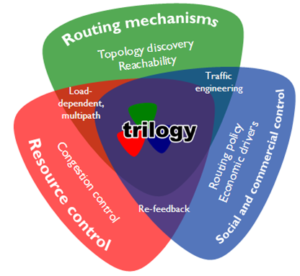IMDEA Networks

El proyecto Trilogy rediseña la infraestructura TIC del mundo
01 Septiembre 2011

El Grupo de investigación NETCOM de la Universidad Carlos III de Madrid, en colaboración con Institute IMDEA Networks, centro de investigación en el área de las redes de ordenadores respaldado por la Comunidad Autónoma de Madrid, ha anunciado la finalización con éxito del Proyecto europeo TRILOGY (Re-architecting the Internet – An Hourglass Control Architecture for the Internet, Supporting Extremes of Commercial, Social and Technical Control).
El proyecto se concibió con el objetivo de habilitar y desarrollar funciones de control de Internet, en concreto la accesibilidad y el control de recursos y ha abarcado tanto la perspectiva comercial como técnica para conseguir resultados relacionados con la arquitectura, protocolos, simulaciones, prototipos y normalización en la Internet Engineering Task Force (IETF).
El proyecto Trilogy comenzó en enero de 2008 y concluyó a finales de marzo de 2011, y ha contado con la participación de socios del sector público y privado, incluidas cinco universidades, cuatro compañías de telecomunicaciones y dos centros de investigación. La dirección del proyecto ha corrido a cargo del doctor Marcelo Bagnulo Braun, profesor asociado del Departamento de Ingeniería Telemática de la Universidad Carlos III (UC3M), miembro del grupo de investigación NETCOM, así como de la Junta de Arquitectura de Internet (IAB) y colaborador habitual del Institute IMDEA Networks. Dos de los investigadores del instituto han participado activamente en el proyecto.
 El ambicioso objetivo de Trilogy consistía en rediseñar la infraestructura TIC del mundo. Entre los resultados del proyecto, se incluye el desarrollo de dos nuevas funciones de control destacadas, que se desplegarán de forma generalizada en la Internet del futuro, para mejorar esta red significativamente.
El ambicioso objetivo de Trilogy consistía en rediseñar la infraestructura TIC del mundo. Entre los resultados del proyecto, se incluye el desarrollo de dos nuevas funciones de control destacadas, que se desplegarán de forma generalizada en la Internet del futuro, para mejorar esta red significativamente.
MPTCP (TCP multirruta) permite distribuir una conexión TCP a través de varias rutas. Entre las ventajas, se incluye una mayor resiliencia (la conexión funciona incluso si una de las rutas falla), un mayor aprovechamiento de la red (agrupamiento de recursos) y una forma de movilidad. Los investigadores del proyecto Trilogy han desarrollado un nuevo algoritmo de control de la congestión que equilibra el tráfico entre varias rutas, alejándolo de las rutas congestionadas y explotando áreas de la red con capacidad no utilizada. Asimismo, han desarrollado un nuevo protocolo de señalización que amplía TCP mediante la agregación y eliminación de rutas. El trabajo abarca la teoría, estudios de adopción, simulaciones, código, normalización y experimentos, especialmente en relación con su aplicación en centros de datos.
CONEX (exposición de la congestión) brinda visibilidad completa de la congestión extremo a extremo a todos los elementos de la red (información que actualmente sólo está disponible en los terminales). Entre las ventajas, cabe citar una mejor gestión del tráfico por parte de la red, un control de la calidad integral del servicio por parte del usuario y una forma de protección contra ataques DDoS (Denegación de servicio distribuido). También han desarrollado un marco de responsabilidad, en concreto un mecanismo de control del tráfico, que utiliza la información de congestión. Este trabajo incluye teoría, estudios de adopción, simulaciones, código, experimentos y normalización.
El proyecto también ha generado amplias investigaciones sobre enrutamiento, como un conjunto de estudios que han caracterizado propiedades clave de los sistemas actuales de enrutamiento. Los investigadores han diseñado, implementado y/o desarrollado, y evaluado varios mecanismos, principalmente dirigidos al enrutamiento multirruta, como Multi-path BGP, BGP Add-Paths y LISP. También han ayudado a desarrollar y normalizar varias otras funcionalidades de accesibilidad, especialmente NAT64 y la validación de la dirección de origen.
Con el objetivo de consolidar los elementos anteriores, se ha desarrollado la arquitectura Trilogy general, que describe cómo encajan los «componentes básicos» (MPTCP, CONEX y el enrutamiento multirruta), y un conjunto de principios de diseño, que crean directrices para capturar el concepto abstracto de «design for tussle». El resultado en ambas iniciativas ha sido un éxito general.
Para fomentar el trabajo de investigación, Trilogy ha organizado más de una docena de talleres, incluidos: «Internet Reloaded» (para conocer las perspectivas sociocomerciales que aplican los líderes de la industria cuya actividad gira en torno a Internet); una escuela de verano (charlas pronunciadas por gurús de Trilogy y de otros ámbitos); un taller sobre implementadores de MPTCP (conversaciones con comunidades de SO sobre aplicaciones y cómo lograr que MPTCP triunfe en la Internet real); y ReArch (una nueva serie de talleres, parte del prestigioso congreso ACM CoNEXT). Varios de los principales oradores y moderadores en dos sesiones plenarias técnicas de la IETF sobre la «Neutralidad de red y la IETF» y «Perspectivas económicas sobre la cogestión» eran miembros de Trilogy.
El proyecto Trilogy ha dado lugar a la publicación de unos 70 artículos en revistas de prestigio, así como en congresos, talleres e incluso capítulos de libros. Asimismo, los socios del proyecto de la IETF han colaborado intensamente con investigadores externos sobre la normalización de Internet. El proyecto Trilogy ha ayudado a establecer dos nuevos grupos de trabajo (MPCTP y CONEX), ha generado o colaborado en la autoría de 9 RFC (Requests for Comments), 12 borradores de Internet elaborados por otros grupos de trabajo y 31 borradores realizados por otras personas.
Trilogy ha sido un proyecto integrado de 3 años y 3 meses de duración, bajo el objetivo 1.1.1 («La red del futuro») del Séptimo Programa Marco de la Unión Europea. El proyecto ha contado con la participación de las siguientes organizaciones: British Telecommunications PLC (Coordinador), Deutsche Telekom AG, NEC Europe Ltd., Nokia Oyj, Roke Manor Research Ltd., Athens University of Economics and Business – Research Center, Universidad Carlos III de Madrid, University College London, Université catholique de Louvain, Eurescom – European Institute for Research and Strategic Studies in Telecommunications, GmbH y Stanford University.


Comentarios recientes